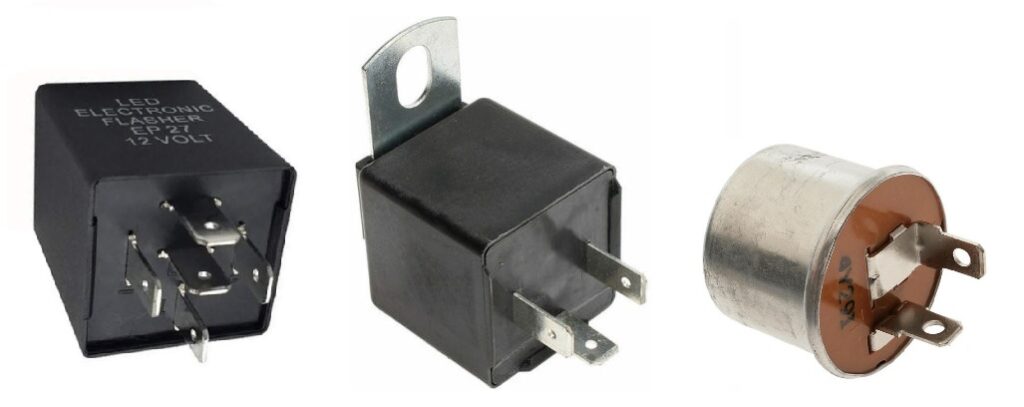Using your hazard and turn signal lights is all part of driving a vehicle. Your safety and that of others on the road depend on these signals being used properly to indicate turns or notify others that something is wrong. That’s why a malfunction in the hazard/turn signal flasher is a big problem.
The hazard and turn signal flashers are either separate or combined into a single hybrid system. These flashers are what give your hazard and turn signal lights their eye-catching on-and-off blink. This blink is achieved when the flasher opens and closes the turn signal circuit.
Different kinds of flashers achieve this opening and closing cycle in different ways. Some platforms don’t use flashers, but depend on a circuit in the body control module (BCM) or a lighting control module (LCM). When the flasher isn’t working properly, then you can observe the following symptoms:

Hazard Lights Keep Flashing
For an electric flasher system, hazard lights sometimes start flashing without stopping. This can cause some trouble. Many states also forbid you from driving around with hazard lights on, which can be impossible with a malfunctioning flasher. This problem can also lead to your battery getting drained and your vehicle losing power. As rare as this may be, it can happen.
A multimeter can help identify a malfunctioning relay as the culprit, but it’s better to use a test light or a load that is equal in current draw to the circuit being tested. This is because a multimeter can fool you into thinking a relay is working when actually it can’t pull an electrical load. Electrical shorts in the system can also cause the same effect. The shorts might also be causing problems in your vehicle’s other electronic components.
Turn Signal Is Stuck and Doesn’t Flash
If your vehicle is equipped with a bimetal or DOT (series-type) flasher, your flashers may not blink and stay on when there’s a problem, like a burned out bulb.
When one bulb burns out, the current flow isn’t enough to keep the other bulb flashing. A signal light that stays on is an easy way to spot when one of your other bulbs is burnt out and needs replacing. Once you have a new bulb in, the flasher goes back to functioning normally.
Turn Signal Is Flashing Quickly
A turn signal that flashes too quickly is also a sign of a burnt-out bulb on most newer cars (older cars don’t do this). This is commonly found on vehicles that use flasher relays or have the flash circuit built into the BCM or LCM or have solid-state turn signal flashers.

Turn Signal Indicator Lamp Is Always On or Flashing Quickly
For certain turn signal flashers, the turn signal indicator lamp on your dashboard will also be affected by a burnt-out bulb.

For electronic flasher units, the indicator lamp will flash at a faster rate than usual if the current draw is less than it would be with two bulbs. Both these are signs that one of your signal lights has burnt out, which causes the flasher to stop functioning like usual.
Cost To Fix a Malfunctioning Hazard or Turn Signal Flasher
The cost of new signal flashers range from $10–$140. If it’s the bulb causing your flasher to malfunction, then prices can go from $10–$850 depending on the model of your vehicle.
Types of Hazard or Turn Signal Flashers
There are many types of hazard/turn signal flashers out there. Identifying what type of flasher is in your vehicle can help you diagnose what’s wrong. It’ll also make buying the replacement parts for your vehicle easier. Here’s a rundown of the two most common variants:
Thermal Flashers
Also known as bimetal flashers, thermal flashers are often found in older vehicles. Keep in mind, however, that many people might not be familiar with the terminology. These flashers would be the common, round two-terminal flashers that were used on cars for decades until about the late 1980s or early 1990s (see photo).
These current-sensitive flashers work using temperature changes in two different metals. Like a circuit breaker, it makes use of the difference in the expansion and contraction of the metals to close and open circuits. When the current is interrupted due to a burnt-out bulb, the temperature changes are no longer drastic enough to open the circuit and cause the flashing except on some flashers of this type that are designed to flash at the same rate even if there’s only one bulb working.
Because they function by constantly distorting metal parts, thermal flashers are known to have shorter lifespans than electronic flashers. Note, however, that it’s also possible for this type of flasher to last the entire life of the vehicle without needing to be replaced.
Electronic Flashers
There are different types of electronic flashers, such as solid state flashers and flasher relays (flashers with three or more terminals). In the case of solid state flashers, they’re entirely electronic with no moving parts. Their timing and load switching rely on an internal electronic circuit and solid-state power output devices.
Meanwhile, flasher relays have an electronic flasher control circuit to run their internal electromechanical relays. They can operate at a wide range of temperatures and voltages thanks to their stable electronic timing circuitry.
Because they rely less on moving parts, electronic flashers last longer than thermal flashers, but they’re also more expensive.
What Do I Do if My Flashing Unit Is Broken?
A malfunctioning hazard or turn signal flasher can be a real danger on the road. If your vehicle is suffering from a malfunctioning flashing unit, you’re legally required to use turn hand signals until it’s fixed. Having this problem repaired as soon as possible is for the best.
Any information provided on this Website is for informational purposes only and is not intended to replace consultation with a professional mechanic. The accuracy and timeliness of the information may change from the time of publication.































